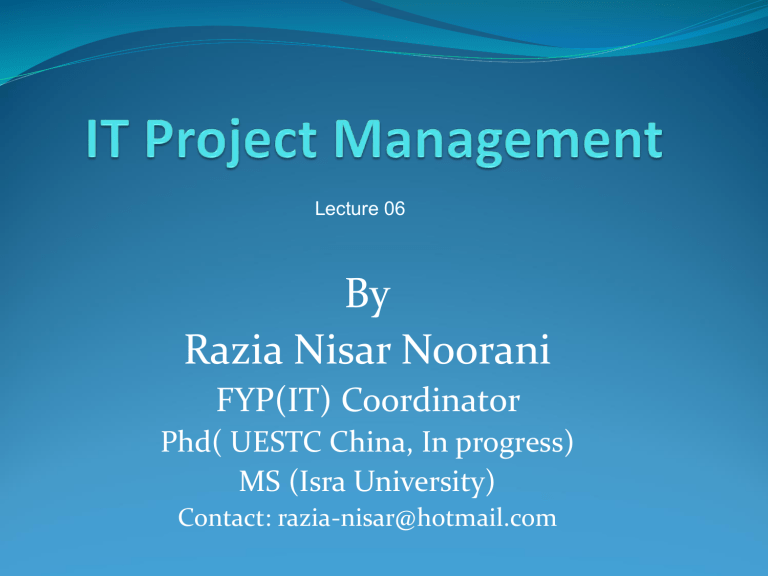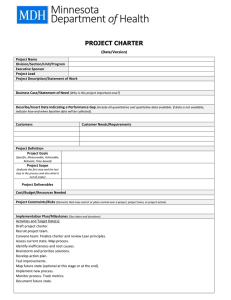
Lecture 06 By Razia Nisar Noorani FYP(IT) Coordinator Phd( UESTC China, In progress) MS (Isra University) Contact: razia-nisar@hotmail.com INITIATING A SOFTWARE PROJECT Initiating the project When a project is initiated, it is being considered; it hasn’t been officially launched. Projects get initiated to fulfill many different needs: A problem needs to be solved. An opportunity needs to be captured. A profit needs to be made. An existing environment needs to be improved. A process needs to be speeded up and/or made more efficient. PM ROLE At the initiation stage, the PM must make an effort to understand the reasons the project is necessary. Empathizing with the project customer (the person paying for the project) and the key stakeholders now can help you stay on track later. Knowing why the project is being created will help you ask the right questions to help the customer get to the desired solution. Identifying the Project Purpose Why is the project being initiated? You first have to know the project purpose. Does everyone agree on this purpose and goals? There must be consensus on what the project will create. There must be consensus on of the project. If not, you can count on trouble before the project is complete. Talking To the Stakeholders There are five questions every project manager should ask stakeholders: 1. What are the factors for completion? You should ask this key question far in advance of starting the project work. As a project manager you need to know what the project will accomplish and be able to plan how to get there. If the qualifications for completion are unknown or fuzzy at best, you’re not ready to get to work. Starting a project without knowing what the end result should be is like building a house without blueprints. 2. What is the goal of this project? Knowing the project’s goal helps you and the team plan. For some projects the goal will be to win new customers, or to make internal processes more efficient, or to solve a problem. Other projects may be financially based. For example, the goal maybe to create this essential transition to VoIP without spending more than$235,000. 3. What are the areas of the organization that this project will affect? The answer to this question tells you who you need to communicate with. It also brings to attention that there may be stakeholders who aren’t attending meetings and should be. Although it’s easy to identify the end-users of your software, there may be “hidden stakeholders” to consider: accounting, security personnel, government agencies, a training team, and so on. 4. What is the project priority? Chances are good you’ll be managing more than one project at a time, and there are equal chances that your project team members will be on multiple projects as well. When you consider these odds it’s best to know your priorities so you know where to spend your energy. Consider your software conformance to the SarbanesOxley Act versus a feature to search a database through a Web browser. Both may be important, but you’ll need to determine which takes priority. 5. What is the accepted range of variance? The range of variance is the +/– value associated with the budget and the schedule. For example, a project may have a budget of $450,000, +45,000 to –$25,000. This means the project could actually cost as much as $495,000 or as little as$425,000. You can actually apply the same methods to the project schedule. This nugget of info can help you plan and react to problems within the project— and you know there’ll be problems. Levels of Organization Each level of your organization has different needs, different concerns, and different goals for your project. You need to address each level of your organization to get the project moving to completion. Talking To the Executives Executives are responsible for setting the vision and direction of their organization. This small group of people (or sometimes even a single person) has a vision for the organization and is interested in taking herself and her employees there. Questions you need to ask executives, assuming you’ll be interacting with this crowd: 1. What are the factors for project success? 2. What’s your vision for the project result? 3. What’s more important, time or budget? 4. What risks do you anticipate for this project’s success? Talking To the Functional Management Their purpose is to carry out the vision of the executives. It’s at this level of the organization that tactics, strategy, and delivery of purpose to the employees take place. Questions you’ll need to ask functional managers: 1. What are the factors for project success? 2. Are there scheduling issues that will affect the project’s end date? 3. What resources are available for the software creation? 4. What departments and customers will need to interact? 5. How will the project team be assembled? 6. Do you have a preset budget in mind for the project? 7. What risks do you see for this project? Talking To the Operations Down deep in the pyramid you’ll find operations. These are the people that do the work. The people in operations focus on the day-to-day activities of getting things done. Questions you’ll need to ask to the operations: 1. What are the factors for project success? 2. How will the software be used? 3. What other software projects are you working on now? 4. What immediate risks do you see in the project? 5. Who has the experience to get this done? 6. Do we need training to create this software? 7. What areas of the project are you dreading? Creating the Project Charter: A project charter is written by the person who has the authority within an organization to authorize the project to move forward. This individual has the positional power to authorize resources and funds. The project charter may be written by the project manager, but is signed by someone with more power in the organization than you. This person typically becomes the project sponsor. Project Charter cont: Technically, the charter should be signed by a person whose role in the organization is higher than all managers that may have employees on your project team. Imagine the trouble if Bob signs a charter authorizing you to use Susan’s resources on your project team, even though Bob has no real authority over Susan. After the charter is signed by your project sponsor, all key stakeholders need a copy of the charter. Some organizations use a boilerplate charter that is sent via e-mail, while other organizations have a formal, paper-based charter that is delivered in hard copy. Either way, all key stakeholders should receive the charter so they’re aware of the official project launch, your authority as the project manager, and who’s the sponsor of the project Completing Stakeholder Analysis Stakeholder analysis is the process of determining who your stakeholders are and what their interests and concerns for their project are. As the project manager, you inherit their vision of the software solution.


